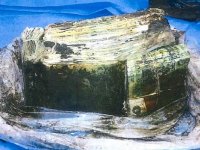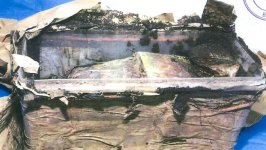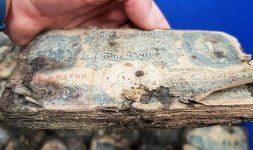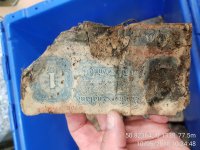MiddenMonster
Bronze Member
The Dutch Schultz stuff got me wondering on how someone could bury a cache of jewels, precious metals and paper money in such a way that it survives 200 - 300 years. Let's say that there is $1 million in cash (100 stacks of $10,000, all $100 bills), and another $4 million in jewels and precious metals. Of course, the jewels and precious metals would have no problem surviving, which means that the paper money is the critical part of the cache.
I don't think that it would as easy as it might seem at first glance. Depending on how you did it there would possibly be rust to deal with. But no matter how you did it there would be moisture of varying degrees, geological forces, erosion, crush stress, etc.
The way I came up with is as follows. First, I'd put the cash in 6" PVC pipe along with a good amount of those desiccant packs. Then I would use PVC glue to fasten end caps to the pipe. At this point the PVC pipe should stay intact and sealed for between 70 and 100 years if it were buried as is. I'd do the same with the jewels and precious metals, though I would probably leave the desiccants out for fear of a chemical reaction with the metals. Once the pipes were all sealed and in front of me I would wrap each of them tightly with a heavy mil garbage bag and use that serial killer's friend known as duct tape to seal the bags as well as possible. I probably wouldn't go with two plastic wraps because any water that got past the outside layer would migrate deeper and deeper into the inner bag. Finally I would put the sealed PVC piped into an iron box of the same gauge as sewer pipe. The method I would use is to put bearing grease several inches deep into the iron box, then continually pack more bearing grease around the PVC pips as I added them to the box. I originally thought of using a large, plastic ice chest, but because of crush stress and ground movement I figured it would break apart after as little as 20 years. I would then seal the lid shut with all weather silicone gel. At this point, the box is pretty much ready to go, but I'd finish it off by covering the entire iron box with a few layers of that Flex Seal liquid that you see in TV commercials. That would give me an iron box that is completely covered with about 3/8" of a rubber coating. I'd find a good spot and bury the chest 3' - 4' deep, and hopefully find a slab rock big enough to cover the top of the chest with a couple inches of overhang on all sides.
I figure the Flex Seal would last at least 2 decades before it began to degrade. 20 years. The cast iron chest should withstand the elements for as long as sewer pipe can last, with is another 80 - 100 years. So let's say we're at 90 years of protection. The bearing grease wouldn't begin to move until the box was sufficiently rusted, and it could only move at the speed of any holes in the iron. The bearing grease would also function as a displacement force against the water, and I figure that would take at least 50 years. 140 years. Once the PVC was exposed it should last another 70 - 100 years, provided it didn't degrade while it was protected. That's 240 years.
Any flaws in that method? What are your ideas on how to do it?
I don't think that it would as easy as it might seem at first glance. Depending on how you did it there would possibly be rust to deal with. But no matter how you did it there would be moisture of varying degrees, geological forces, erosion, crush stress, etc.
The way I came up with is as follows. First, I'd put the cash in 6" PVC pipe along with a good amount of those desiccant packs. Then I would use PVC glue to fasten end caps to the pipe. At this point the PVC pipe should stay intact and sealed for between 70 and 100 years if it were buried as is. I'd do the same with the jewels and precious metals, though I would probably leave the desiccants out for fear of a chemical reaction with the metals. Once the pipes were all sealed and in front of me I would wrap each of them tightly with a heavy mil garbage bag and use that serial killer's friend known as duct tape to seal the bags as well as possible. I probably wouldn't go with two plastic wraps because any water that got past the outside layer would migrate deeper and deeper into the inner bag. Finally I would put the sealed PVC piped into an iron box of the same gauge as sewer pipe. The method I would use is to put bearing grease several inches deep into the iron box, then continually pack more bearing grease around the PVC pips as I added them to the box. I originally thought of using a large, plastic ice chest, but because of crush stress and ground movement I figured it would break apart after as little as 20 years. I would then seal the lid shut with all weather silicone gel. At this point, the box is pretty much ready to go, but I'd finish it off by covering the entire iron box with a few layers of that Flex Seal liquid that you see in TV commercials. That would give me an iron box that is completely covered with about 3/8" of a rubber coating. I'd find a good spot and bury the chest 3' - 4' deep, and hopefully find a slab rock big enough to cover the top of the chest with a couple inches of overhang on all sides.
I figure the Flex Seal would last at least 2 decades before it began to degrade. 20 years. The cast iron chest should withstand the elements for as long as sewer pipe can last, with is another 80 - 100 years. So let's say we're at 90 years of protection. The bearing grease wouldn't begin to move until the box was sufficiently rusted, and it could only move at the speed of any holes in the iron. The bearing grease would also function as a displacement force against the water, and I figure that would take at least 50 years. 140 years. Once the PVC was exposed it should last another 70 - 100 years, provided it didn't degrade while it was protected. That's 240 years.
Any flaws in that method? What are your ideas on how to do it?





 ..But my very first thought. Convert the paper to gold and silver. I'd be worried the cash would become worthless. I doubt gold and silver will become worthless. I also wonder.....If burying cash in a place where temp is fairly consistent would help.
..But my very first thought. Convert the paper to gold and silver. I'd be worried the cash would become worthless. I doubt gold and silver will become worthless. I also wonder.....If burying cash in a place where temp is fairly consistent would help.












